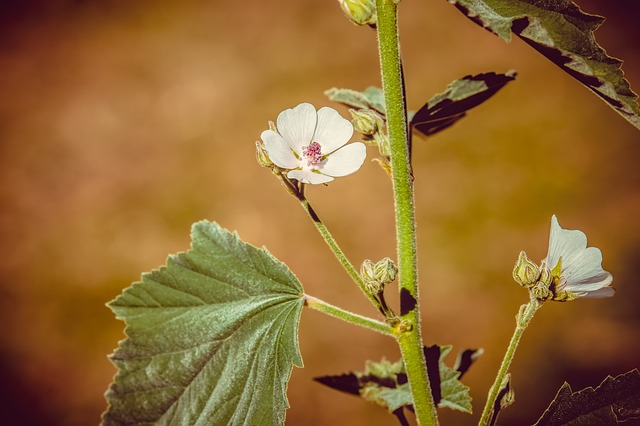 |  |  |  |  |
 |  |  |
Marshmallow officinalis is a perennial densely pubescent plant due to the presence of stellate branched hairs, has one or more stems and a strong branched short rhizome with rather thick, long fleshy roots. The stems are mostly erect, simple, sometimes branched in the upper part, from 50 to 150 cm high. The leaves are alternate, depending on the placement on the stem, they have a different shape of the leaf blade. The upper leaves are long-petiolate, ovate, pointed, unevenly tubular-toothed at the edges, ovate-oblong, three-lobed with an elongated middle scapula, and broadly wedge-shaped at the base; middle leaves are slightly rounded or almost flat at the base; the lower leaves are larger and wider than the rest, three-, five-lobed, sometimes heart-shaped at the base. All marshmallow leaves are grayish-green in color and pubescent. Althea flowers are located on pedicels, crowded at the top of the stem and placed on common peduncles emerging from the axils of the upper and middle leaves, with a subcup, characteristic of plants of the Malvaceae family; sepals broadly ovate, hairy, pointed. Corolla pale pink, not very open, consists of 5 petals; petals are broadly ovate, deeply notched at the apex, narrowed near the base. The fruits are small, disc-shaped combined achenes, wrapped in a cup, pubescent with short hairs, up to 7-10 mm in diameter. Seeds are dark brown, smooth, reniform, 2-2.5 mm long. The plant blooms in summer from June to August, the fruits ripen from July.
In medicine, in industrial pharmacy, marshmallow roots (Althaeae radices) are most widely used as medicinal raw materials.
Althea roots are harvested at the beginning of the growing season before the growth of the aerial part (March - May), and also in the fall, when the stems begin to dry out. The dug roots are cleaned of soil and washed in cold water, dried a little in the sun and cut into pieces up to 30 cm, and thick roots are cut lengthwise into 2-3 parts; to obtain peeled roots, the gray surface layer is peeled off before drying. After the roots are dried in the shade, laying out in a thin layer, on nets, stretched panels, in the open air in attics and in well-ventilated areas. In dryers, raw materials are dried at a temperature not exceeding 40 ° C.
To obtain medicinal raw materials, another type of marshmallow is used - Armenian marshmallow (lat. Althaea armeniaca Ten.).
Marshmallow belongs to plants containing mucus, therefore, in the phytochemical aspect, the polysaccharides of marshmallow roots are the most well studied. It has been found that marshmallow roots contain 30 to 35% mucus. In 1912, monosaccharides, D-glucose and D-L-xylose, were identified in the mucus of the plant, and in 1946, uronic acids, methylpentoses, and hexoses were found. Dry mucus contains from 19.52 to 21.68% of reducing polysaccharides in terms of glucose. In addition to mucus, marshmallow roots contain from 5 to 11% of the linear polysaccharide triticin and up to 78% of inverted sugars, tannins (from 4.11 to 7.96%), essential amino acids, in particular asparagine (from 0.8 to 2%) and betaine (up to 4%); starch (37%), pectin (11-20%), fat (2%), organic acids, carotene.
MEDICINAL IMPORTANCE
Althea officinalis has an expectorant, enveloping, anti-inflammatory and mild analgesic effect, which is due to the high content of heterogeneous mucus. Althea root in the modern pharmacological nomenclature belongs to the group of antitussives. Mucous decoction of marshmallow root, flowing down the back wall of the pharynx, wets the vocal cords, penetrates into the trachea, softening the dense coating, protects the nerve endings of the mucous membranes of the pharynx and trachea from irritants and accelerates the healing of the affected areas of the mucous membrane. In addition, due to its colloidal properties, mucus facilitates expectoration.
When used together with other more active anti-inflammatory drugs, marshmallow root mucus has the ability to slow down their evacuation, which contributes to a longer and more complete effect of other medicines on the affected areas.
An aqueous extract of marshmallow root, taken orally, also has an enveloping effect on the gastric mucosa. The effectiveness of the enveloping action increases with increased acidity of gastric juice, since when interacting with hydrochloric acid, the viscosity of mucus increases. Plant mucus from the marshmallow root and colloidal aqueous solutions envelop the mucous membranes of the organs with a thin layer for a long time, protecting them from further irritation by harmful factors, in particular cold or dry air, chemical irritants, preventing them from drying out and creating favorable conditions for healing. Mucus is able to adsorb and inactivate toxins from bacteria and viruses, toxic products that damage epithelial cells, and prevents contact of toxins with the mucous membrane. As a result of the action of mucus, spontaneous regeneration of damaged tissues decreases, and the intensity of the inflammatory process decreases.
For medical purposes, infusions, decoctions, dry and liquid extracts of the root, marshmallow syrup are used.
In folk medicine, water infusion of marshmallow roots as an adjuvant is used for inflammation of the mucous membrane of the respiratory organs with a large separation of mucus: for whooping cough, pneumonia, bronchitis, cough. The infusion is used for inflammation of the bladder, painful and involuntary urination, inflammation of the intestines, for simple diarrhea, dysentery, dyspeptic diarrhea in children, kidney disease, and especially for stomach and duodenal ulcers.
